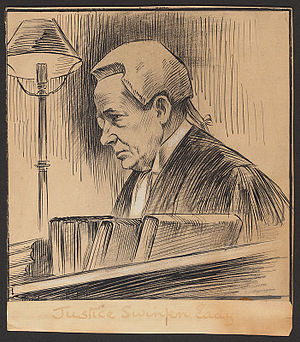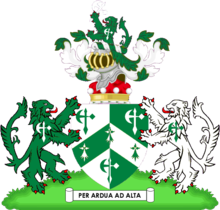
Earl of Carlisle is a title that has been created three times in the Peerage of England.

Marquess Townshend is a title in the Peerage of Great Britain held by the Townshend family of Raynham Hall in Norfolk. The title was created in 1787 for George Townshend, 4th Viscount Townshend.

Earl of Enniskillen is a title in the Peerage of Ireland. It was created in 1789 for William Cole, 1st Viscount Enniskillen. He had already been created Viscount Enniskillen in the Peerage of Ireland in 1776 and had inherited the title Baron Mount Florence, of Florence Court in the County of Fermanagh, which had been created in the Peerage of Ireland in 1760 for his father John Cole, who had earlier represented Enniskillen in the Irish House of Commons.

Baron Walsingham, of Walsingham in the County of Norfolk, is a title in the Peerage of Great Britain.

Baron Langford, of Summerhill in the County of Meath, is a title in the Peerage of Ireland. It was created on 1 July 1800 for Clotworthy Rowley, who had earlier represented Trim and County Meath in the Irish House of Commons. Born Clotworthy Taylor, he was the fourth son of Thomas Taylor, 1st Earl of Bective and Jane Rowley, daughter of Hercules Langford Rowley and his wife Elizabeth Rowley, 1st Viscountess Langford. The viscountcy of Langford became extinct in 1796 on the death of Hercules Rowley, 2nd Viscount Langford. Clotworthy Taylor succeeded to the Rowley estates and assumed by Royal licence the surname of Rowley in lieu of Taylor. Four years later the Langford title was revived when he was raised to the Peerage of Ireland as Baron Langford.
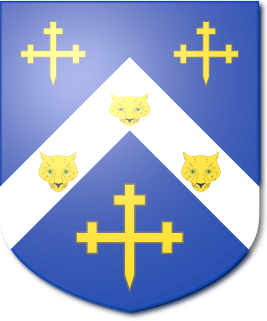
Baron Rayleigh, of Terling Place in the County of Essex is a title in the Peerage of the United Kingdom.

Baron Faringdon, of Buscot Park in the County of Oxfordshire, is a title in the Peerage of the United Kingdom. It was created in 1916 for Sir Alexander Henderson, 1st Baronet, who had previously represented Stafford West and St George's, Hanover Square in the House of Commons as a Liberal Unionist. He had already been created a baronet in 1902. He was succeeded by his grandson, the second Baron. He was the son of the Hon. Harold Henderson, eldest son of the first Baron, who predeceased his father. Lord Faringdon was a member of the London County Council. As of 2017 the titles are held by his nephew, the third Baron, who succeeded in 1977. He is the son of the Hon. Michael Thomas Handerson, second son of the Hon. Harold Henderson.

Baron Hemphill, of Rathkenny and of Cashel in the County of Tipperary, is a title in the Peerage of the United Kingdom. It was created on 12 January 1906 for the lawyer and Liberal politician Charles Hemphill, Solicitor-General for Ireland between 1892 and 1895. His elder son, the second Baron, was Crown Prosecutor for County Wicklow. He was succeeded by his younger brother, the third Baron. He was Deputy Chairman of the London County Council from 1907 to 1908. The fifth Baron, who succeeded his father in 1957, assumed by deed poll in 1959 the additional surname of Martyn, which was the maiden name of his father's mother, a first cousin of Edward Martyn. As of 2017 the title is held by the latter's son, the sixth Baron, who succeeded his father in 2012.

Baron Glenconner, of The Glen in the County of Peebles, is a title in the Peerage of the United Kingdom. It was created in 1911 for Sir Edward Tennant, 2nd Baronet, who had earlier represented Salisbury in the House of Commons as a Liberal and also served as Lord Lieutenant of Peeblesshire. Lord Glenconner was succeeded by his second son, the second baron. The latter was succeeded in 1983 by his eldest son, the third baron, who bought the island of Mustique. As of 2014, the titles are held by the third baron's grandson, the fourth baron, who became the next-to-youngest peer in the realm when he succeeded in August 2010.

Baron Amherst of Hackney, in the County of London, is a title in the Peerage of the United Kingdom. It was created on 26 August 1892 for the former Conservative Member of Parliament William Tyssen-Amherst, with remainder, in default of male issue, to his eldest daughter Mary and her issue male. Tyssen-Amherst had previously represented West Norfolk and South West Norfolk in the House of Commons. He was succeeded according to the special remainder by his daughter Mary. She was the wife of Colonel Lord William Cecil, third son of William Cecil, 3rd Marquess of Exeter. As of 2017 the title is held by their great-great-grandson, the fifth Baron, who succeeded his father in 2009. As a male-line descendant of the third Marquess of Exeter he is also in remainder to this peerage and its subsidiary titles the earldom of Exeter and barony of Burghley.

Baron Leigh has been created twice as a hereditary title, once in the Peerage of England and once in the Peerage of the United Kingdom. The first creation came in the Peerage of England 1643 when Sir Thomas Leigh, 2nd Baronet, was created Baron Leigh, of Stoneleigh in the County of Warwick. The Leigh Baronetcy, of Stoneleigh in the County of Warwick, had been created in 1611 for his grandfather and namesake Thomas Leigh. The latter was the second son of Sir Thomas Leigh, Lord Mayor of London in 1558, whose third son Sir William Leigh was the grandfather of Francis Leigh, 1st Earl of Chichester. The titles became extinct on the death of the fifth Baron Leigh in 1786.
Baron Keyes, of Zeebrugge, and Dover in the County of Kent, is a title in the Peerage of the United Kingdom. It was created in 1943 for the prominent naval commander Admiral of the Fleet Sir Roger Keyes, 1st Baronet. He is chiefly remembered for his role in the Zeebrugge Raid in 1918, an attempt by the Royal Navy to neutralize the Belgian port of Zeebrugge which was used as a base for German submarine attacks on Allied shipping. Keyes had already been created a Baronet, of Zeebrugge, and of Dover in the County of Kent, in the Baronetage of the United Kingdom in 1919. As of 2010 the titles are held by his grandson, the third Baron, who succeeded his father in 2005. He does not use his title.
Baron Killearn, of Killearn in the County of Stirling, is a title in the Peerage of the United Kingdom. It was created in 1943 for the diplomat Sir Miles Lampson. He was the second son of Norman Lampson, youngest son of Sir Curtis Lampson, 1st Baronet, of Rowfant. Lord Killearn's eldest son, the second Baron, succeeded his second cousin once removed as fourth Baronet in 1971. On his death the titles passed to his half-brother, the third and present holder of the barony and baronetcy.

Baron Newton, of Newton-in-Makerfield in the County Palatine of Lancaster, is a title in the Peerage of the United Kingdom. It was created in 1892 for the Conservative politician William Legh, who had earlier represented Lancashire South and Cheshire East in the House of Commons.

Baron Parmoor, of Frieth in the County of Buckingham, is a title in the Peerage of the United Kingdom. It was created on 16 January 1914 for the lawyer and politician Sir Charles Cripps. He and his wife, Marian Ellis, were anti-war activists. Two of his sons, the second and third Baron, both succeeded in the title. The third Baron was succeeded by his son, the fourth Baron. As of 2010 the title is held by the latter's first cousin, the fifth Baron, who succeeded in 2008. He is the grandson of Major the Hon. Leonard Harrison Cripps, third son of the first Baron.
Baron Basing, of Basing Byflete and of Hoddington, both in the County of Southampton, is a title in the Peerage of the United Kingdom. It was created in 1887 for the Conservative politician and former President of the Local Government Board, George Sclater-Booth. On his death the title passed to his eldest son, the second Baron, and then to his son, the third Baron. On the latter's death in 1983 this line of the family failed. The title was inherited by the late Baron's first cousin, the fourth Baron. He was the son of Hon. Charles Lutle Sclater-Booth, second son of the first Baron. As of 2010 the title is held by the fourth Baron's grandson, the sixth Baron, who succeeded his father in 2007.

Baron Burnham, of Hall Barn in the Parish of Beaconsfield in the County of Buckingham, is a title in the Peerage of the United Kingdom. It was created on 31 July 1903 for the influential newspaper magnate Sir Edward Levy-Lawson, 1st Baronet, owner of The Daily Telegraph. He had already been created a Baronet, of Hall Barn in The Parish of Beaconsfield in the County of Buckingham and of Peterborough Court in the City of London, in the Baronetage of the United Kingdom on 13 October 1892. Levy-Lawson was the son of Joseph Moses Levy, who acquired The Daily Telegraph only months after its founding.
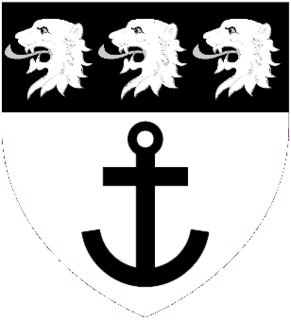
Baron Ritchie of Dundee, of Welders in the Parish of Chalfont St Giles in the County of Buckingham, is a title in the Peerage of the United Kingdom. It was created in 1905 for the Conservative politician Charles Ritchie. He was Home Secretary between 1900 and 1902 and Chancellor of the Exchequer between 1902 and 1903.
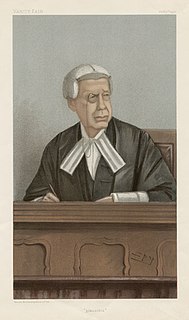
Charles Swinfen Eady, 1st Baron Swinfen,, was a British lawyer and judge.

Roger Mynors Swinfen Eady, 3rd Baron Swinfen, was a British politician and philanthropist, who was one of the ninety two hereditary peers elected to remain in the House of Lords following the passing of the House of Lords Act 1999. He sat as a Conservative.
